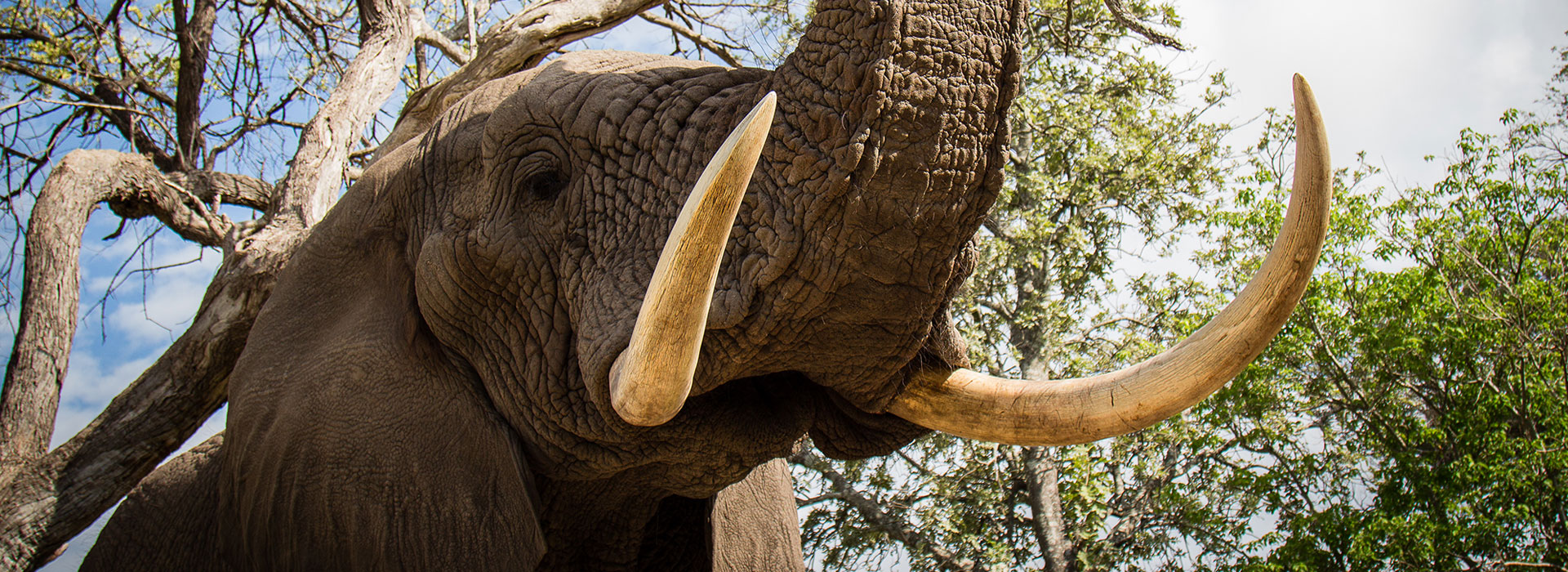ELEPHANT FACTS
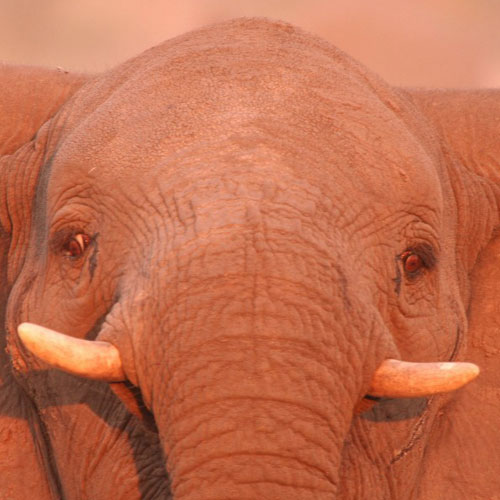
General Elephant Facts
Did you know that the word “Elephant” is actually latin for “huge Arch”? These animals certainly are huge and impressive beasts. In fact, the elephant is the largest living land mammal in the world.
A male elephant can grow up to 4 metres in height and weigh up to 7 tonnes; whilst their females counterparts can still weigh in at a mere 3.5 tonnes.
To feed an animal of such gigantic proportions takes a lot of food. Their daily food intake is almost as much as 4-7% of their body weight. When you are an elephant, that equates to finding and eating an awful lot of food. As you would expect, all that food needs to be digested and dozed off, which is why our elephant friends can deposit upwards of 150 kg of dung daily! Eew!
Elephants are herbivores and only eat grasses, herbs, fruit, plants and trees. Their healthy, vegetarian diet is obviously good for them as the average elephant has a life span of around 70 odd years, a bit like we do
Despite their size, they are actually pretty nimble and can walk up to 195 km per day, although they usually only average is only 25 km on a daily basis. They can also run faster than you would expect, easily reaching speeds of 40 mph, which is a lot faster than us humans can run.
Where once elephants roamed across the whole of Africa, they are now limited to conservation areas and the Savannah. African and Asian elephants can currently be found in 37 African countries, and across 13 Asian countries.
Most people believe that there are only two species of elephant in the word, but in fact there are three:
- African savannah, Loxodonta africana
- African forest, Loxodonta cyclotis
- Asian, Elephas maximus
There are actually two very different species of African elephants living on the African continent, both very different in their culture and appearance.
Elephants are gentle, intelligent creatures that must be protected to ensure that they remain part of our natural ecosystem for centuries to come.
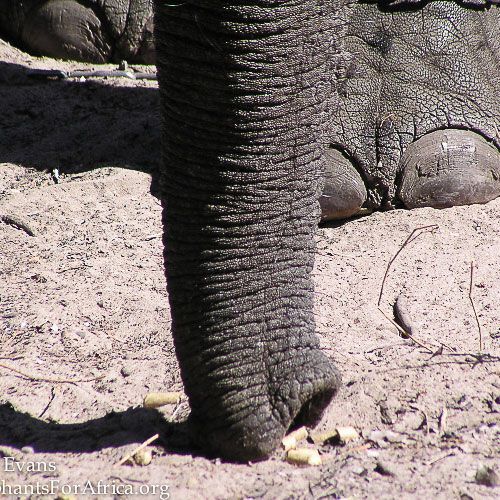
Elephant Anatomy
We know that elephants are big, and that they have trunks, but what else do we know about the anatomy of these beautiful beasts?Well, an elephant’s trunk is actually a fusion of the upper lip and an elongated nose. The trunk alone can weigh as much as 140 kg and can be a used as a deadly weapon. However, a trunk can also be used to pick up a feather, offer comfort to a distressed calf, push over a tree and hold 12 litres of water.
In case you hadn't noticed, elephants also have tusks. These are made of ivory and are present in both male and female African elephants. The tusks are actually elongated incisor teeth that first appear at two around years of age. The males’ tusks are heavy and can weigh over 100 kg. Unfortunately, man’s greed for ivory has led to a massive decrease in elephant populations throughout the world as they hunt and kill them for their tusks. To give you an idea of just how many elephants are lost to the ivory trade, in the 1970's there were 1.3 million elephants; now there are only an estimated 400,000 left.
Elephants also have rather large ears. They are designed this way to pump blood around them to help cool the elephant down under the hot African sun. The more the ears flap, the hotter the elephant is.
They say an elephant never forgets. This could be because they are extremely intelligent creatures and have brains that can weigh as much as 4-6 kg.
The skin of an elephant can be up to 2.5 cm thick in places. Despite this, elephants are very prone to skin parasites and use mud and dust baths to try and get rid of them, as well as to cool off.
Elephant have six sets of teeth that grow one set after another, throughout their lives. By the time they reach their 50's, most elephant have started to use their final set.
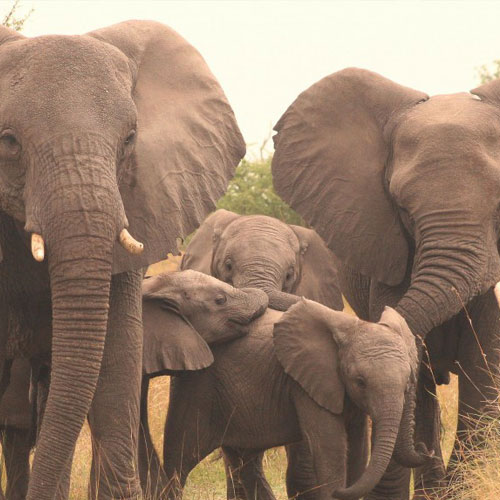
Elephant Social behaviour
Elephants are social animals who tend to live in large groups. They are known for their ability to stay within “family” groups for the duration of their lives, and never stray far from their own mothers.It is definitely a case of “girl power” in the elephant world as the females and their young live in breeding herds, whilst the males are often cast aside.
There is usually one leader, the matriarch, who is often the oldest female, with the rest of the herd being made up of her own offspring. Being the oldest, she has the experience and knowledge that will ensure the survival of the herd in times of hardship. She will take them to water and food beyond their usual range, and teach them how to protect themselves from danger.
Young females will usually stay with the herd, whilst the males leave the herd during adolescence (between the ages of 10 and 19 years) to lead the life of a more solitary bull elephant.
Bull elephants are also known as “bachelors” and often seen with other male elephants to form small groups of their own. Family life is definitely all about mums and their babies, although the male elephants are usually not too far away, keeping an eye on their offspring.
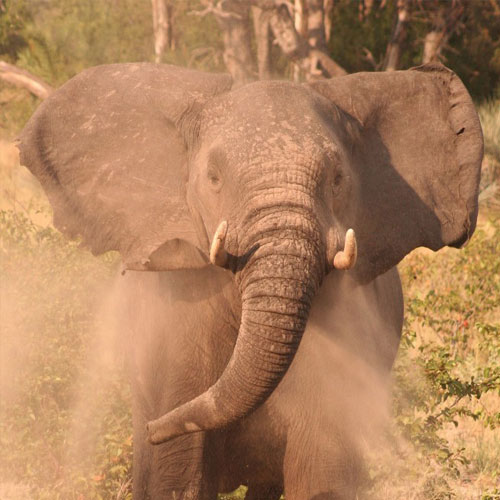
Elephant Communication
Elephants are highly intelligent, social animals that use a variety of different means to communicate with each other. Like humans, they love to talk to each other by vocalising a range of calls and sounds. Research shows that as many as 70 different calls have already been identified, ranging from the loud trumpets of panic to the comforting rumbles of reassurance. They also use infrasound (sounds that are at a frequency inaudible to humans) calls which can be heard up to 14km away.Recent evidence also suggests that they may also be able to communicate through seismic waves that pass through the ground, which they pick up through their sensitive feet.
Like many other animals, elephants also use smells to pick up information about other elephants and their environment. For example, a male can tell when a female is ready to mate from the chemical signs she leaves in her urine and faeces. This, combined with the characteristic calls of that time, ensures that all the local males will know when the time is right to compete for her affections.
Elephants secrete chemicals from temporal glands that are behind their eyes. We do not fully understand their function but it does appear to be linked to chemical communication.
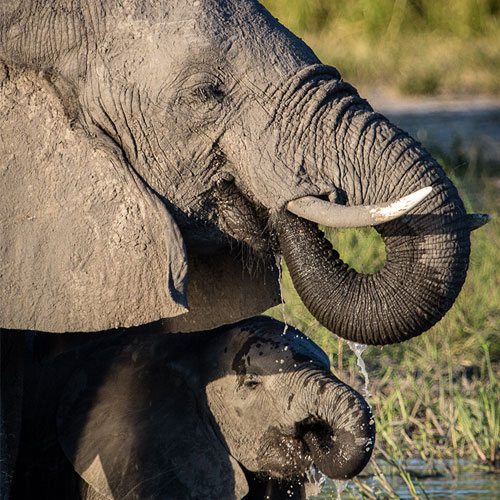
Elephant Reproduction
Reproduction is one of the most important elements of nature. It ensures the continuation of every species, and every species does it differently!In the elephant world, females are generally ready to become a mum at around 15-16 years old and can give birth to as many as 12 calves throughout the course of their lives.
Whilst we consider the human gestation period to be lengthy, at a mere 9 months, be thankful you are not an elephant! The average gestation period for a female elephant is a whopping 22 months. That’s a long time!
Female elephants must have a thing for the older man, as males do not come into their prime until they are between 30-35 years of age. Around this time, they experience period of “musth”. Musth is a periodic condition in bull elephants that is characterised by highly aggressive behaviour and is accompanied by a large rise in reproductive hormones. Testosterone levels in an elephant in musth can be as much as 60 times greater than in the same elephant at other times.
Musth can last for as long as six months in the dominant males and they will often stop feeding for several days during this period of time.
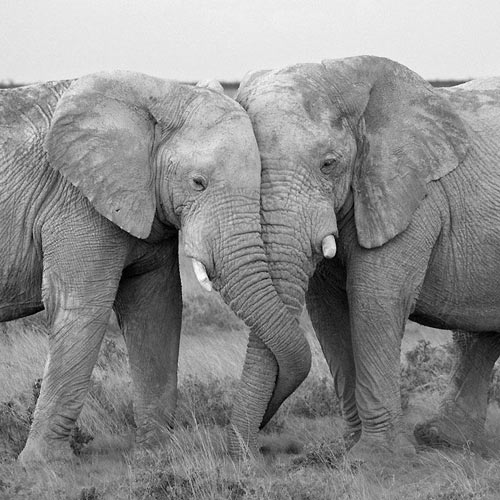
Elephant Love and Relationships
Rumour has it that elephants mate for life. Whilst this is not necessarily true, animal scientist have proven that they will never stray far from mating partners.They are known to be able to develop strong and intimate bonds between friends and family members. They can form lifelong friendships and will often only move in the same groups for their entire life. Elephants are also known to mourn the death of a loved one, and have even been seen grieving over stillborn calves, or baby elephants who do not survive the first few months of life. Family groups have even been known to return to the locations where friends or family members died and linger there for some time.
There is also plenty of truth in the old adage that “Elephants never forget” which helps them to forge long term relationships. Elephants need excellent memory skills in order to survive in the wild, and can recognise a previous companion or family member by the scent of their urine alone.
So, whilst elephants may not quite be as romantic as we like to think they are, there is certainly a lot of evidence that they do form strong bonds with their own social networks. Elephants can live for up to 70 years in the wild, so being part of a group is important to them.
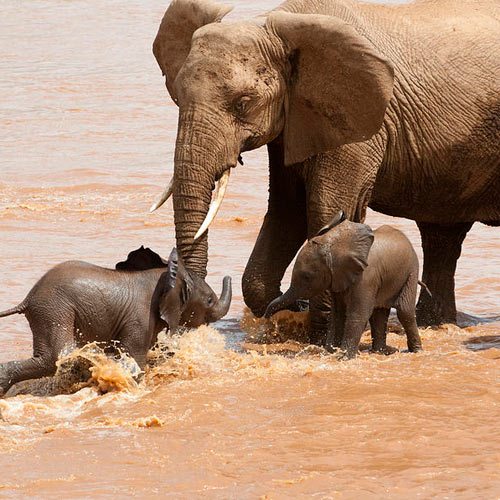
Baby Elephant Facts
Baby elephants are cute - there are no two ways about that. But, they are also highly evolved and one of the most advanced species when it comes to their new born capabilities. Female elephants (also called “cows”) have the longest gestation period of all mammals, lasting as long as 23 months! After spending so long being nurtured by their mummies bellies, it’s no surprise that baby elephants are pretty smart little babies when they are finally welcomed to the world.A baby elephant is called a calf and can weigh around 200 lbs (91 kg) and stand about 3 feet (1 m) tall. They can't see very well when they are born, but much like human babies, they can recognise their mothers by touch, scent, and sound. For the first few months, the babies stay very close to their mothers for food, warmth and support. They are hungry little things too, and can consume as much as 3 gallons of their mothers milk every day. Weaning is not a speedy process for elephants either, as babies can continue to drink their mothers milk until they are as much as 10 years old.
Luckily, the female elephant community is social and supportive, with young calves being tended to not only by their mothers, but also by other females in the herd. When a new baby is born, all of the females in the group trumpet the news and announce the new arrival. Within minutes of being born, the calf must stand on its own four feet, literally. Calves need to be upright in order to reach their mothers milk, otherwise they will perish.
For the first year of their lives, their trunks are not something they are able to control very well. Much like human babies, elephants learn their behaviour from parents and older family member, including how to put their trunks to good use.
Much more so than other animals, elephant babies exclusively learn how to adapt to their new surroundings by following the behaviour of their mothers over a long period of time. This means that they stay close to their parents and family members for much of their childhood.
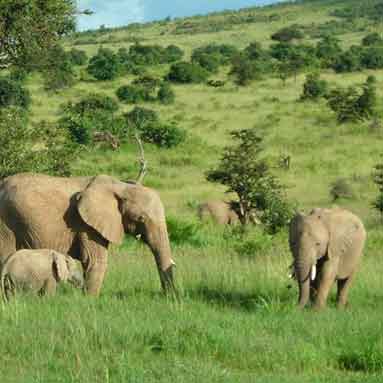
African elephant Habitat Facts
African elephants live in sub-Saharan Africa, the rain forests of Central and West Africa and the Sahel desert in Mali. Their Asian contemporaries can be found in Nepal, India and Southeast Asia in scrub forests and rain forests.Elephants are mighty beasts, and they have evolved to survive perfectly well in hot, arid conditions. They are herbivores, meaning that they eat leaves, roots, fruits and grasses but do not eat the meat of other animals. They are the gentle vegetarian giants of the African Savannahs and can be found wandering through as many as 37 countries on the African continent.
Elephants stamp and dig into dry stream beds or other spots to uncover water that is lurking below the surface. They often create very large holes by digging with their feet, trunks and tusks, working until they reach an adequate supply of water for them all to share.
Their sheer size along makes them hard for predators to eat, such as leopards, lions, or jaguars. At night, the adults form a circle around the calves to protect them from danger. They also have thick skin, making it hard to bite.
Africa is also home to Forest Elephants who have uniquely adapted to live in the forest habitat of the Congo Basin. These elephants have evolved to survive in their own habitat and are smaller in size, making them better suited to life in the lush rainforest conditions. Sadly, it is the forest elephants of Africa that are more at risk from the threat of poachers than any other, and their numbers continue to steadily decline.
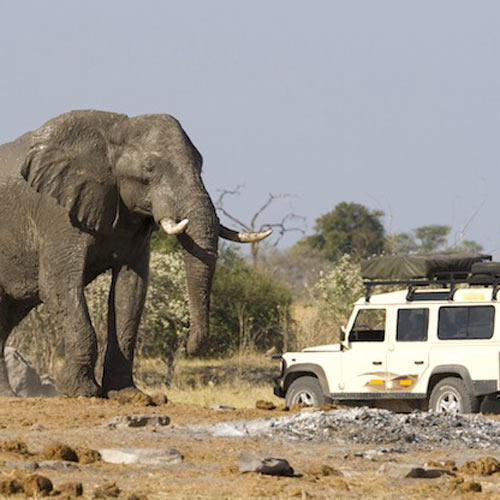
Facts about Elephant Size
African elephants are the largest land animals in the world today. The largest African elephant ever recorded was found in Angola, rocking in at a massive 24,000 lb (11,000 kg), with a shoulder height of 3.96 meters (13.0 ft), and being at least a metre taller than the average male African elephant!The average African elephant will grow to between 8.2 to 13 feet (2.5 to 4 meters) from shoulder to toe and weigh between 5,000 to 14,000 lbs. (2,268 to 6,350 kilograms), according to the National Geographic.
Male elephants can grow to be significantly larger than their female counterparts. Still a mighty animal, female elephants, or “Cows” only grow to somewhere around 9 and 13 feet and weigh from 6,000 to 8,000 pounds.
Both genders grow ivory tusks, which are actually elongated incisor teeth. However, the male's tusks are longer and heavier, weighing between 110 and 175 pounds each. Females' tusks weigh approximately 40 pounds each.
African elephants are famous for their very large ears. Considered to be shaped much like the continent of Africa itself, the large surface area of their ears helps to keep them cool in the blazing hot African sun.
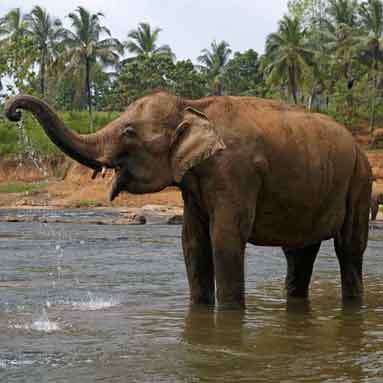
Indian Elephant Facts
Whilst we love and support our elephants here on the African continent, their brothers and sister in Asia also deserve our recognition. Asian or Indian elephants look different to our African species, but effectively are still the same gentle giants loved the world over.Indian elephants tend to be smaller in stature than African elephants and have adapted to live in the lush, wet and humid conditions of tropical Asia. The shape of their heads and the size of their ears also makes Asian elephants easy to identify.
African elephants have fuller, more rounded heads. The top of the head is a single dome, whereas Asian elephants have a twin-domed head with an indent in the middle. The lower lips of the two species also differ, being long and tapered in Asian elephants and short and round in African elephants.
All African elephants have tusks, whereas only some male Asian elephants have tusks, with females not having them at all.
It is said that African elephants have ears shaped like a map of Africa, whilst Asian elephants have smaller ears shaped like a map of India. Whilst this may or may not be exactly the case, Asian elephants do have smaller ears as they do not rely on bigger ears to shade them from the hot African sun.
Asian Elephants Under Threat
Whilst our African elephants are most at risk from poaches and the Ivory trade in general, the greatest threat to Asian elephants is the potential loss of habitat as forests are cleared to make way for dams, tea and coffee plantations, roads, and railway lines.
Frequently asked questions
Where do elephants come from?There are three species of elephants in the world, and where each one can be found depends on the species.
In Africa, there are two species of elephant. The loxodonta africana African elephant lives in the African Savannah and in the Sahel desert in Mali. This is the biggest species of elephant in the world. The slightly smaller loxodonta cyclotis African elephant lives in the rainforests of Central and West Africa.
Where once elephants roamed across the whole of Africa, they are now limited to conservation areas and the Savannah. African and Asian elephants can currently be found in 37 African countries, and across 13 Asian countries.
The elephas maixmus species of elephant (Asian elephant) can be found in Nepal, India and Southeast Asia in scrub forests and rain forests.
How many elephants are there in Africa and why are African elephants endangered?
There are now only an estimated 400,000 African elephants left in the wild.
African elephants are endangered largely owing to man’s greed for ivory which had to elephants being hunted and killed for their valuable tusks. To give you an idea of just how many elephants are lost to the ivory trade, in the 1970's there were 1.3 million elephants. Less than a third of that number are now left. African Forest Elephants living in the forests of the Basin are at the greatest risk from the threat of poachers than any other species and their numbers continue to steadily decline.
Moreover, humans are responsible for huge habit loss of African elephants. As the human population in Africa increases, more and more land is converted to agriculture. A smaller habit has meant that elephants and humans are coming into contact with one another more than they did historically, and this is causing conflict. Elephants are very intelligent creature and sometimes raid farmers’ crop for food. This can lead to both humans and elephants being killed in the conflict.
How much does the average elephant weigh?
African elephants are the largest land animals in the world today. The average African elephant will weigh between 5,000 to 14,000 lbs. (2,268 to 6,350 kg), according to the National Geographic. However, the largest African elephant ever recorded was found in Angola, rocking in at a massive 24,000 lb (11,000 kg).
Male elephants can grow to be significantly larger than their female counterparts. Still a mighty animal, female elephants, or “Cows”, only grow to weigh from 6,000 to 8,000 pounds.
Asian elephants tend to be a smaller than their African counterparts, weighing between 4,400 to 11,000 Ibs (2,000 to 5,000 kg).
How tall is an elephant?
African elephants are the largest land animals in the world today. The average African elephant will grow to between 8.2 to 13 feet (2.5 to 4 m) tall, measured from shoulder to toe, according to the National Geographic.
Male elephants can grow to be significantly larger than their female counterparts. Still a mighty animal, female elephants, or “Cows”, only grow to somewhere between 9 and 13 feet.
Asian elephants are smaller and tend to reach a shoulder height of between 6.6 and 11.5 feet (2 and 3.5 m) tall.
What do African elephants eat?
Elephants are herbivores and only eat grasses, herbs, fruit, plants and trees.
How much does an elephant eat a day?
Elephants are gigantic animals and this means that they need to find an eat an awful lot of food. Their daily food intake is almost as much as 4-7% of their body weight. African elephants can eat as much as 330 Ibs (150 kg) of food a day.
What is elephant dung and how much does elephant poop weigh?
Much of the grasses and plants that elephants eat aren’t actually digested by elephants so this simply comes out in their dung. In fact, because of this, some animals like monkeys and dung beetles actually eat elephant dung!
And there’s plenty of it around. Our elephant friends can deposit upwards of 150 kg of dung daily! Eew!
How do elephants have sex?
Female elephants are generally ready to become a mum at around 15-16 years old. A male can tell when a female is ready to mate from the chemical signs she leaves in her urine and faeces. This, combined with the characteristic calls of that time, ensures that all the local males will know when the time is right to compete for her affections.
Female elephants must have a thing for the older man, as males do not come into their prime until they are between 30-35 years of age. Around this time, they experience period of “musth”. Musth is a periodic condition in bull elephants that is characterised by highly aggressive behaviour and is accompanied by a large rise in reproductive hormones.
Rumour has it that elephants mate for life. Whilst this is not necessarily true, animal scientist have proven that they will never stray far from mating partners.
How do elephants give birth?
Like other mammals, female elephants give birth to fairly developed babies via her birth canal.
An elephant pregnancy lasts around 22 months, meaning that new born baby elephants are not small! A baby elephant is called a calf and can weigh between 200 and 300 lbs and stand about 3 feet (1 m) tall.
How many babies do elephants have?
Typically, elephants only give birth to one calf at a time, although twins do sometimes occur. In her lifetime (elephants can live for up to 70 years in the wild!), a female elephant can give birth to as many as 12 calves.
Not as many as babies you might think? Well that’s because the average gestation (pregnancy) period for a female elephant is a whopping 22 months. That’s a long time!
How many teeth do elephants have?
Elephants usually have 26 teeth at any one time. Throughout their lives, elephants have six sets of teeth that grow one set after another. By the time they reach their 50's, most elephant have started to use their final set which is needed to last for the rest of their life.
Why do elephants flap their ears?
African elephants are famous for their very large ears. They are designed this way to pump blood around them to help cool the elephant down under the hot African sun. The more the ears flap, the hotter the elephant is.
How thick is elephant skin?
The skin of an elephant can be up to 2.5 cm thick in places. Despite this, elephants have very sensitive skin and use mud and dust baths to protect their skin from burning in the sun, and to get rid of skin parasites.
How far do elephants walk in a day?
Despite their massive size, elephants are actually pretty nimble and can walk up to 195 km per day, although they usually only average is only 25 km on a daily basis.
How much does an elephant's brain weigh?
Elephants are extremely intelligent creatures and an elephant’s brain can weigh as much as 4-6 kg. No wonder they say that an elephant never forgets!
How long is an elephant's trunk?
An elephant’s trunk is usually around 6 feet in length, but can be up to 7 feet long. The trunk alone can weigh as much as 140 kg and can hold 12 litres of water.
How fast do elephants run?
Elephants can run faster than you would expect, easily reaching speeds of 40 mph - a lot faster than us humans can run!

